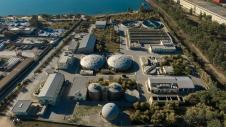The Hellenic Corporation of Assets and Participations (HCAP) is putting together a plan to develop Greece’s freight centers, and logistics in general, as part of a push for the broader development of state assets.
The administration of Gregory Dimitriadis has decided to apply a more aggressive tactic in utilizing the Superfund’s portfolio of real estate and other assets. The plan for the development of the four freight centers, in Thriasio, Thessaloniki, Larissa and Igoumenitsa, is not enough for the country to benefit from its geographical position and to function as a hub in transit trade, say market watchers as they point out that significant investments are required to hook up freight centers with ports and the railway. In a bid to complete this, the Ministry of Infrastructure is preparing to launch in the autumn, six major tenders totaling 3.3 billion euros.
In regards to its broader logistics development plan, the Superfund will prepare a strategic plan. This will help prevent it from competing with MPs from Larissa and Magnesia on where the freight center for Thessaly will be built, as is the case now.
A recent announcement from the Deputy Minister of Transport, Giannis Kefalogiannis, saying that the construction of a freight center in an area adjacent to the closed factory of the Hellenic Sugar Industry in Larissa has been met with opposition from locals, prompting a strong reaction from the MPs of Magnesia, who want it to be built close to the port of Volos.
The latter has been taken by Greece’s privatization office (HRADF) but procedures have been delayed in order to create a package of assets that will be more attractive to investors.
The Superfund, via GAIAOSE, does not only own this land in Larissa. It is also the owner of the former Gonou military camp in Thessaloniki, in the area where the freight center will be built. In fact, the previous management of GAIAOSE, before the company was transferred to EESYP, had announced a tender that was left in the middle. As for Igoumenitsa, a freight center has been planned for decades with almost nothing being done. In terms of the plan’s maturation, some steps have been made since there is a plot (near the Egnatia Odos) and several studies have progressed.
The logistics plan will include both the new framework for OSE network charges, which will span for ten years, and the supply of new rolling stock from GAIAOSE. Initiatives are also being undertaken to address delays at cross-border crossings and customs procedures that hold back the movement of goods by train to Central Europe. The connections of the railway network with large customers, such as the refineries of Motor Oil, as well as the large freight centers like Thriasio, are also seen as having a positive impact.
Professor Thanassis Ziliaskopoulos, chairman of the National Supply Chain Committee, who will also assume the position of non-executive chairman at HRADF, had recently stated at the Delphi Forum that initiatives are needed for driver training, a ten-year plan for network usage charges and the development of infrastructure. Rolling stock maintenance is also an important issue. He believes, however, that the interoperability of networks in south-eastern Europe must move forward quickly.










